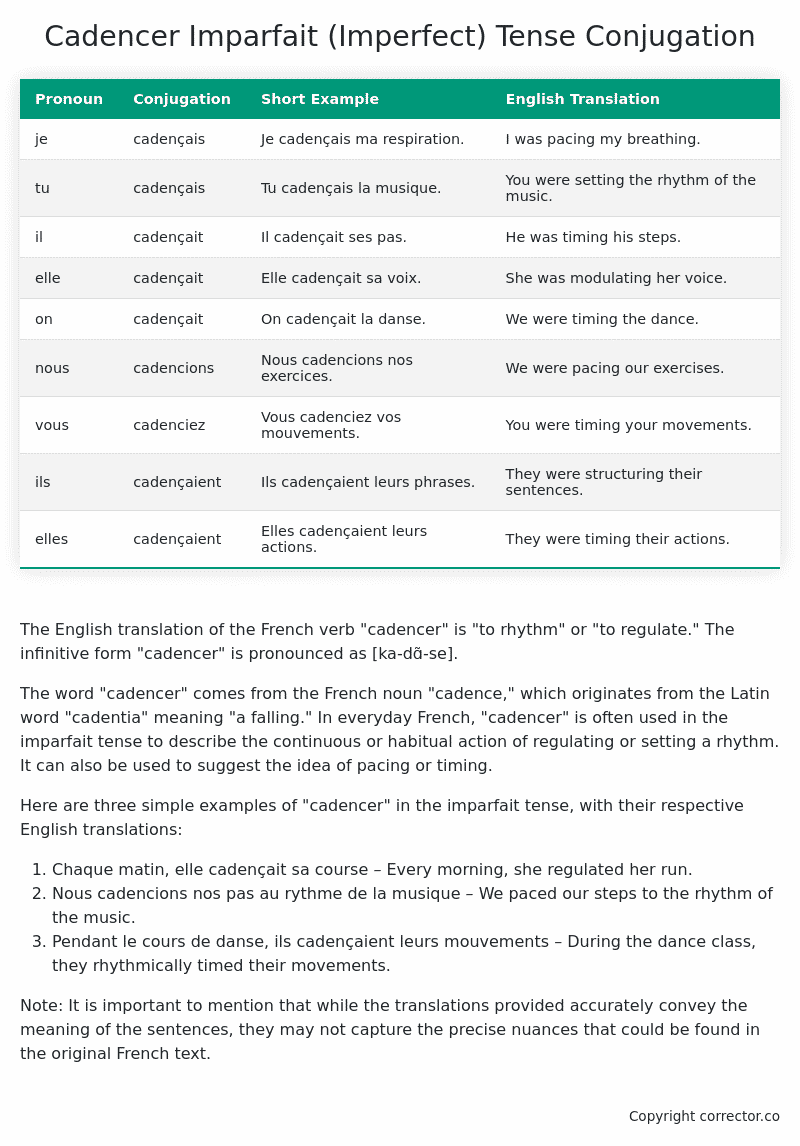Imparfait (Imperfect) Tense Conjugation of the French Verb cadencer
Introduction to the verb cadencer
The English translation of the French verb “cadencer” is “to rhythm” or “to regulate.” The infinitive form “cadencer” is pronounced as [ka-dɑ̃-se].
The word “cadencer” comes from the French noun “cadence,” which originates from the Latin word “cadentia” meaning “a falling.” In everyday French, “cadencer” is often used in the imparfait tense to describe the continuous or habitual action of regulating or setting a rhythm. It can also be used to suggest the idea of pacing or timing.
Here are three simple examples of “cadencer” in the imparfait tense, with their respective English translations:
- Chaque matin, elle cadençait sa course – Every morning, she regulated her run.
- Nous cadencions nos pas au rythme de la musique – We paced our steps to the rhythm of the music.
- Pendant le cours de danse, ils cadençaient leurs mouvements – During the dance class, they rhythmically timed their movements.
Note: It is important to mention that while the translations provided accurately convey the meaning of the sentences, they may not capture the precise nuances that could be found in the original French text.
Table of the Imparfait (Imperfect) Tense Conjugation of cadencer
| Pronoun | Conjugation | Short Example | English Translation |
|---|---|---|---|
| je | cadençais | Je cadençais ma respiration. | I was pacing my breathing. |
| tu | cadençais | Tu cadençais la musique. | You were setting the rhythm of the music. |
| il | cadençait | Il cadençait ses pas. | He was timing his steps. |
| elle | cadençait | Elle cadençait sa voix. | She was modulating her voice. |
| on | cadençait | On cadençait la danse. | We were timing the dance. |
| nous | cadencions | Nous cadencions nos exercices. | We were pacing our exercises. |
| vous | cadenciez | Vous cadenciez vos mouvements. | You were timing your movements. |
| ils | cadençaient | Ils cadençaient leurs phrases. | They were structuring their sentences. |
| elles | cadençaient | Elles cadençaient leurs actions. | They were timing their actions. |
Other Conjugations for Cadencer.
Le Present (Present Tense) Conjugation of the French Verb cadencer
Imparfait (Imperfect) Tense Conjugation of the French Verb cadencer (You’re reading it right now!)
Passé Simple (Simple Past) Tense Conjugation of the French Verb cadencer
Passé Composé (Present Perfect) Tense Conjugation of the French Verb cadencer
Futur Simple (Simple Future) Tense Conjugation of the French Verb cadencer
Futur Proche (Near Future) Tense Conjugation of the French Verb cadencer
Plus-que-parfait (Pluperfect) Tense Conjugation of the French Verb cadencer
Passé Antérieur (Past Anterior) Tense Conjugation of the French Verb cadencer
Futur Antérieur (Future Anterior) Tense Conjugation of the French Verb cadencer
Subjonctif Présent (Subjunctive Present) Tense Conjugation of the French Verb cadencer
Subjonctif Passé (Subjunctive Past) Tense Conjugation of the French Verb cadencer
Subjonctif Imparfait (Subjunctive Imperfect) Tense Conjugation of the French Verb cadencer
Subjonctif Plus-que-parfait (Subjunctive Pluperfect) Tense Conjugation of the French Verb cadencer
Conditionnel Présent (Conditional Present) Tense Conjugation of the French Verb cadencer
Conditionnel Passé (Conditional Past) Tense Conjugation of the French Verb cadencer
Conditionnel Passé II (Conditional Past II) Tense Conjugation of the French Verb cadencer
L’impératif Présent (Imperative Present) Tense Conjugation of the French Verb cadencer
L’impératif Passé (Imperative Past) Tense Conjugation of the French Verb cadencer
L’infinitif Présent (Infinitive Present) Tense Conjugation of the French Verb cadencer
L’infinitif Passé (Infinitive Past) Tense Conjugation of the French Verb cadencer
Le Participe Présent (Present Participle) Tense Conjugation of the French Verb cadencer
Le Participe Passé (Past Participle) Tense Conjugation of the French Verb cadencer
Struggling with French verbs or the language in general? Why not use our free French Grammar Checker – no registration required!
Get a FREE Download Study Sheet of this Conjugation 🔥
Simply right click the image below, click “save image” and get your free reference for the cadencer imparfait tense conjugation!

Cadencer – About the French Imparfait Tense
NOTE: To take a deep dive into all the French tenses then see our article on Mastering French Tense Conjugation.
Formation of the Imparfait Tense
For regular -er verbs:
For regular -ir verbs
For regular -re verbs
Common Everyday Usage Patterns
Description of Past Habits
Background Information
Mental and Emotional States
It’s employed to express emotions, thoughts, or physical sensations in the past. For example: “J’étais content quand il est arrivé.” (I was happy when he arrived.)
Ongoing Actions
Points to Note About the Imparfait Tense
Passé Composé vs. Imparfait
Conditional
Si Clauses
Narration
I hope you enjoyed this article on the verb cadencer. Still in a learning mood? Check out another TOTALLY random French verb imparfait conjugation!


